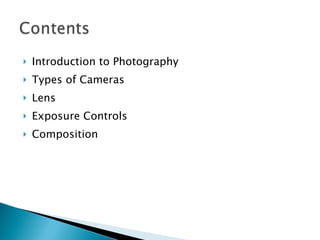Photography - Basics
- 1. Ėý
- 2. Introduction to Photography Types of Cameras Lens Exposure Controls Composition
- 3. Photography relates to the action of light on sensitive bodies in the production of pictures, the fixation of images. "Photography" is derived from the Greek words photos ("light") and graphein ("to draw") The word was first used by the scientist Sir John F.W. Herschel in 1839. It is a method of recording images by the action of light, or related radiation, on a sensitive material.
- 4. A camera is a device that records/stores images. The term camera comes from the camera obscura ( Latin for "dark chamber"), an early mechanism for projecting Images. The still camera takes one photo each time the user presses the shutter button .
- 5. Box camera Folding Camera Pinhole Camera Twin Lens Reflex Point & Shoot View Camera Range Finder Single Lens Reflex
- 6. Wide Angle Lens(24mm-35mm) Normal Lens(50mm) Telephoto Lens(70mm-250mm) Special Lenses Macro Lens Fish Eye Lens
- 7. Normal Lens â 50mm Telephoto Lens â 70mm to 300mm Wide Lens â 24mm to 35 mm
- 8. Shutter Speed The shutter blocks all light from exposing the film until you press the button. Then it quickly opens and closes, giving the film a brief flash of light. You can control the length of time the shutter remains open by setting the SHUTTER SPEED. Longer shutter speeds = more light shorter shutter speeds = less light
- 9. The Aperture Before light reaches film, it must pass through an opening called an "Aperture". The aperture is like a pupil. You can control the aperture by setting the "Aperture Opening", also known as an F-Stop.
- 10. Rule of Thirds Balancing Elements Depth Cropping Viewpoint Background Framing
- 11. Ėý











